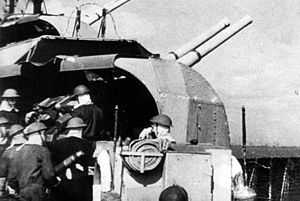ORP Krakowiak (L115)
 ORP Krakowiak's artillery turret in action | |
| Career (Poland) | |
|---|---|
| Name: | ORP Krakowiak |
| Builder: |
J.S. White & Co. Cowes, United Kingdom |
| Laid down: | 5 December 1939 |
| Launched: | 4 December 1940 |
| Commissioned: | 28 May 1941 |
| Decommissioned: | 1946 |
| Fate: | scrapped in 1959 |
| General characteristics | |
| Class and type: | Type II Hunt-class destroyer |
| Displacement: | standard: 1,050 t total: 1,490 t |
| Length: | 85.0 m (278 ft 10 in) |
| Beam: | 9.5 m (31 ft 2 in) |
| Draft: | 2.4 m (7 ft 10 in) |
| Speed: | 27 knots (50 km/h; 31 mph) |
| Armament: | 6 × 102 mm (4.0 in) universal Mk XVI guns 4 × 40 mm (1.6 in) Pom-Pom AA cannons 4 × Oerlikon 20 mm (0.79 in) AA cannons 2 × Lewis machine guns 2 × depth charge launchers 2 × Thornycroft depth charge mortars 110 depth charges |
ORP Krakowiak was a British Hunt II-class destroyer escort, used by the Polish Navy during World War II. Initially built for the Royal Navy, it bore the name of HMS Silverton during British use.
History
The ship was laid down on 5 December 1939 in the J. Samuel White Shipyard in Cowes. Almost a year later it was launched and commissioned by the Royal Navy as HMS Silverton. However, it never entered service in the British naval forces due to lack of experienced crews. Instead, on 20 April 1941 she was leased to the Polish Navy. Officially commissioned on 22 May of that year, she was renamed ORP Krakowiak, after either a folk dance from Kraków or an inhabitant of that city.
As she was the first ship of her class to be handed to the Poles, until 10 July 1941, her crew spent most of their time training and getting to know the ship. After that date she entered line service in convoy escort role in the North Atlantic. In December of that year she was among the ships to take part in the successful raid against a German naval outpost at Lofoten islands. Throughout the war she also patrolled the North Sea, often engaging in skirmishes with German torpedo boats. In 1943 she was moved to the Mediterranean, where she took part in, among others, the Operation Husky, the Allied invasion of Sicily, and later in the Dodecanese Campaign. Altogether, during World War II she crossed more than 146,000 nautical miles (270,000 km) escorting 206 different convoys, including 9 in the North Atlantic. She downed three enemy planes, but the number of enemy vessels sunk is unclear.
Postwar
After the Allied powers withdrew their support for the Polish government, on 28 September 1946 the ship was decommissioned by the Polish Navy and returned to the British, who commissioned it under its original name and placed her in reserve at Devonport.[1] She was reclassified as a frigate and given a new number - F 55. Serving in only rare cases, she spent most of the time in docks, preserved as part of the Reserve Fleet. As such she represented the Reserve Fleet during Queen Elizabeth's coronation celebrations in Spithead in July 1953. In 1959 she was finally decommissioned and sold to Thomas W. Ward Ltd for scrapping, arriving at Grays in Essex in March of that year.
References
- ↑ Critchley, Mike, "British Warships Since 1945: Part 3: Destroyers", Maritime Books: Liskeard, UK, 1982. ISBN 0-9506323-9-2, page 32
Publications
Colledge, J. J.; Warlow, Ben (2006) [1969]. Ships of the Royal Navy: The Complete Record of all Fighting Ships of the Royal Navy (Rev. ed.). London: Chatham Publishing. ISBN 978-1-86176-281-8. OCLC 67375475.
External links
- ORP Krakowiak at uboat.net
| ||||||||||||||||||||||||||||||||||||||||||||||||||||||||||||||||||||||||||||||||||||||||||||||||||||||||||